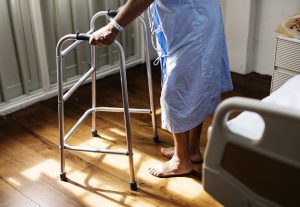As we get older, we lose muscle size and strength and become more vulnerable to injury (de Souto Barreto 2009; Fried et al. 2005). Each year, 1 in 3 individuals over 65 has a fall (Yoshida 2007), which often leads to fractures, hospital admissions and mortality. Strength and balance exercise can help us maintain our strength and help us stay upright, reducing our risk of falls when we stand and walk (Gillespie et al. 2012; Sherrington et al. 2017; Tricco et al. 2017).
However, for a number of older adults, attending regular supervised exercise sessions at a gym can be a challenge. Older adults report numerous barriers to exercise participation such as transportation, cost, lack of time and even fear (Cohen-Mansfield et al. 2003). Home-based exercise programs may be an alternative, as they overcome some of these challenges. However, home-based exercise is typically performed without supervision. So the question is: is unsupervised exercise as effective as exercise performed with supervision?
Researchers at the University of Potsdam in Germany recently reviewed all the published studies on the effects of exercise supervision on muscle strength and static and dynamic balance in older adults (Lacroix et al. 2017). Eleven studies met their eligibility criteria and included a total of 621 participants. The authors compared the effect of supervision on measures of static balance such as tandem stance and single leg stance as well as measures of dynamic balance such as the tandem walk and 15-metre walk tests. They also included measures of strength such as the 30-second Chair-Stand test.
WHAT DID THEY FIND?
Overall, supervised exercise was more effective than unsupervised exercise in improving dynamic balance and muscle strength in older adults, despite no difference in adherence rates. Supervision was not important for improving static balance. However, due to the small number of studies, the authors were unable to establish a clear dose-response relationship between the amount of supervision and the degree of improvement in clinical outcomes.
SIGNIFICANCE AND IMPLICATIONS
Supervised exercise leads to greater improvements in muscle strength and dynamic balance in older people than unsupervised exercise. Why is this the case? The benefits of supervision may include participants utilizing better exercise technique, performing exercise with more sets and repetitions or at higher intensities, and having a greater cognitive challenge. Interestingly, the better outcomes from supervised exercise are present despite no difference in adherence rates between supervised and unsupervised exercise programs (Lacroix et al. 2017).
Clinically, the results from the review mean that fully supervised programs should be given precedence over purely unsupervised exercise training programs. In cases where fully supervised programs are not feasible, at least partially supervised sessions should be considered for better outcomes.
PUBLICATION
Lacroix A, Hortobágyi T, Beurskens R, Granacher U. Effects of supervised vs. unsupervised training programs on balance and muscle strength in older adults: a systematic review and meta-analysis. Sports Med 47: 2341–2361, 2017.
KEY REFERENCES
Cohen-Mansfield J, Marx M, Guralnik JM. Motivators and barriers to exercise in an older community-dwelling population. J Aging Phys Act 11: 242-253, 2003.
de Souto Barreto P. Exercise and health in frail elderly people: a review of randomized controlled trials. Eur Rev Aging Phys Act 6: 75-87, 2009.
Fried LP, Hadley EC, Walston JD, Newman AB, Newman A, Guralnik JM, et al. From bedside to bench: research agenda for frailty. Sci Aging Knowledge Environ 2005: pe24, 2005.
Gillespie LD, Robertson MC, Gillespie WJ, Sherrington C, Gates S, et al. Interventions for preventing falls in older people living in the community. Cochrane Database Syst Rev 12: CD007146, 2012.
Sherrington C, Michaleff ZA, Fairhall N, Tiedemann A, Whitney J, et al. Exercise to prevent falls in older adults: an updated systematic review and meta-analysis. Br J Sports Med 51: 1750-1758, 2017.
Tricco AC, Thomas SM, Veroniki AA, Hamid JS, Cogo E, et al. Comparisons of interventions for preventing falls in older adults: a systematic review and meta-analysis. JAMA 318: 1687-1699, 2017.
Yoshida S. A global report on falls prevention: epidemiology of falls. World Health Organisation.
AUTHOR BIO
 Hassan Qureshi is a PhD candidate at the University of New South Wales (UNSW), in association with Neuroscience Research Australia (NeuRA). His research is in the field of proprioception, with a special interest in perception of location and body ownership. Hassan completed his Bachelors of Exercise Physiology from UNSW in 2015. He has worked as an Accredited Exercise Physiologist (AEP) at an Aged Care Facility, in both residential and community care. He is currently practising as an AEP in a Medical Centre in Western Sydney, where he helps clients with musculoskeletal and metabolic conditions adopt exercise interventions.
Hassan Qureshi is a PhD candidate at the University of New South Wales (UNSW), in association with Neuroscience Research Australia (NeuRA). His research is in the field of proprioception, with a special interest in perception of location and body ownership. Hassan completed his Bachelors of Exercise Physiology from UNSW in 2015. He has worked as an Accredited Exercise Physiologist (AEP) at an Aged Care Facility, in both residential and community care. He is currently practising as an AEP in a Medical Centre in Western Sydney, where he helps clients with musculoskeletal and metabolic conditions adopt exercise interventions.

